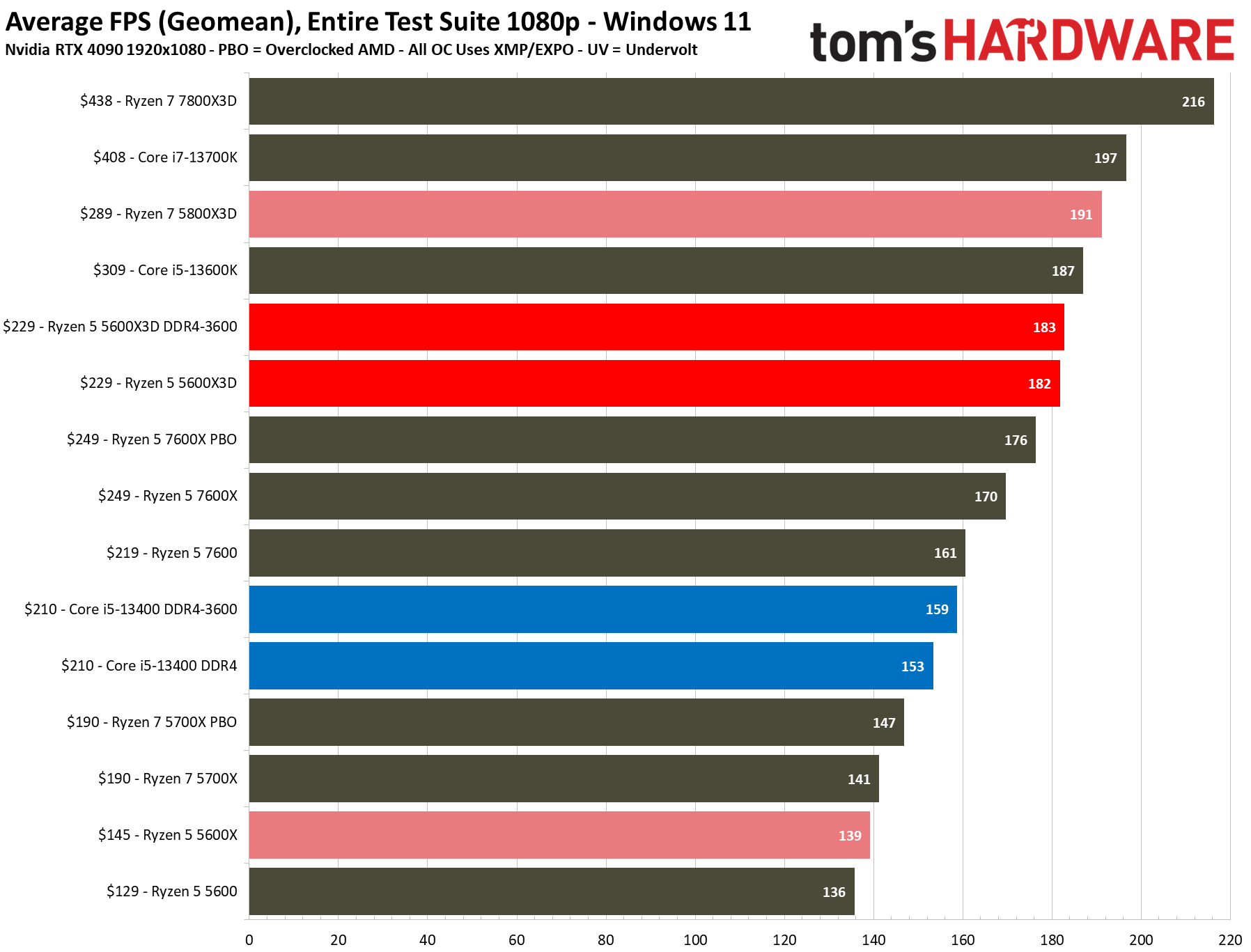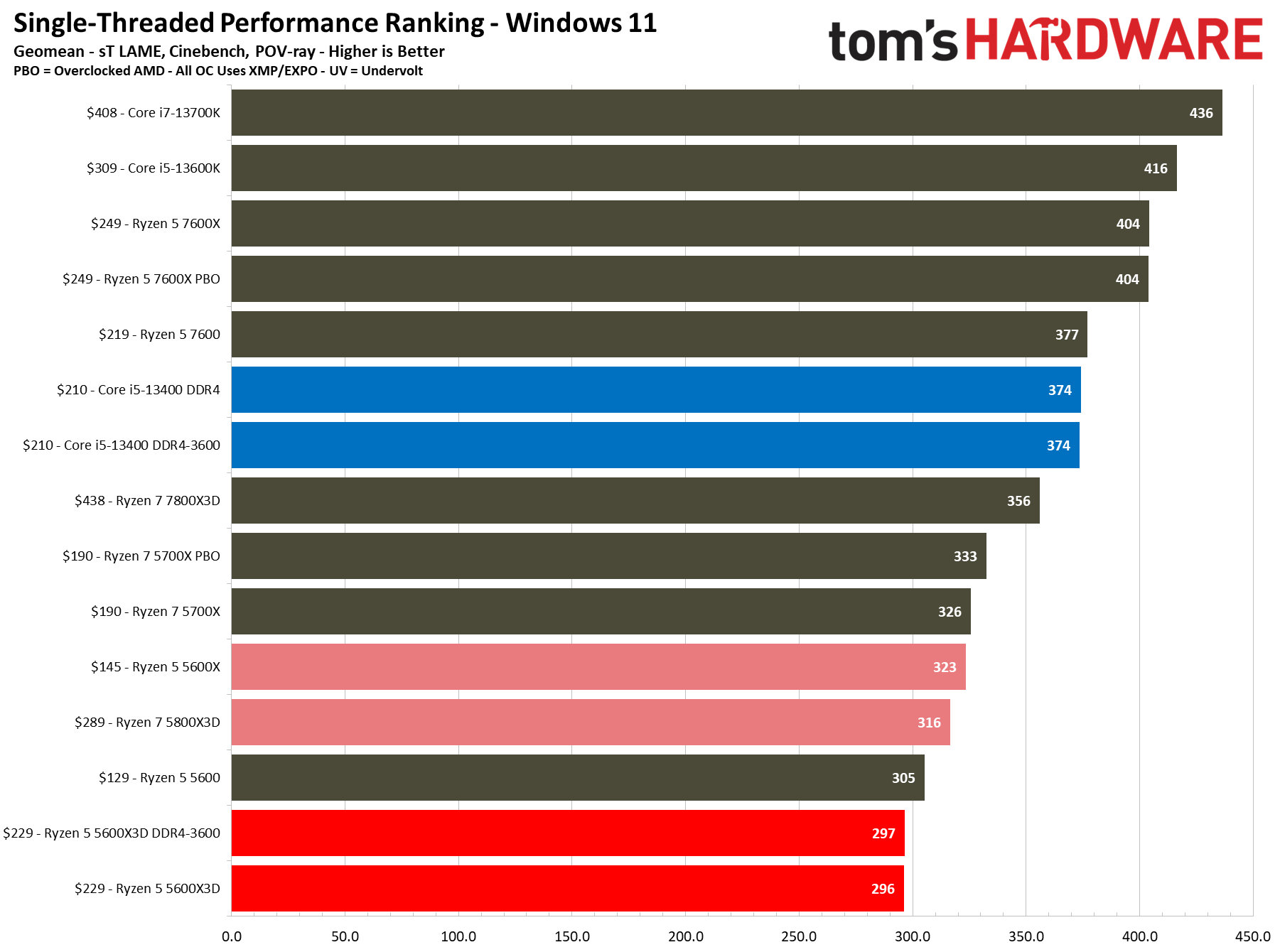Why you can trust Tom's Hardware
The limited-edition Ryzen 5 5600X3D is almost exactly what you’d expect from a smaller Ryzen 7 5800X3D model, providing 95% of the gaming performance of its pricier counterpart for 20% less cash. That also equates to Intel-beating gaming performance that sets a new bar for mid-range chips. However, this specialized processor is specifically optimized for gaming, so it trails Intel’s competing Core processors in productivity applications.
Below, we have the geometric mean of our gaming test suite at 1080p and 1440p and a cumulative measure of performance in single- and multi-threaded applications. We conducted our gaming tests with an Nvidia RTX 4090, so performance deltas will shrink with lesser cards and higher resolution and fidelity settings. This is especially important to remember with these lower-end processors as they will be paired with lower-end GPUs.






The Ryzen 5 5600X3D is ~20% faster than the Core i5-13400 in our cumulative measure of 1080p gaming, and it’s also faster than all the standard Zen 3 and Zen 4 processors, sans the Ryzen 7 5800X3D. You’ll have to step up to the much more expensive Ryzen 7000X3D or an expensive K-series Intel processor to find faster gaming performance. Head to our gaming page for the full title-by-title breakdown.
The Ryzen 5 5600X3D is optimized for gaming, but the 3D V-Cache tech results in lower clock speeds that hamper performance in productivity applications. The chip also leverages the previous-gen Zen 3 architecture, so application performance is particularly lackluster compared to newer Ryzen 7000 chips. For instance, the Intel Core i5-13400 is 35% faster in threaded applications and 26% faster in single-threaded work than the 5600X3D, highlighting that it’s the far better choice if you’re looking for an all-rounder.
While you gain tremendously in gaming performance, you will lose quite a bit of performance in productivity apps if you select a 5600X3D. If you’re upgrading an existing AM4 rig and looking for a more well-rounded chip in this price range, the Ryzen 7 5700X is a solid choice.
The Ryzen 5 5600X3D doesn’t officially support overclocking the CPU cores or adjusting the voltages in any way. Unofficial workarounds do exist but are risky. You can fully overclock both the memory and fabric, but this results in meager performance gains.
One of the Ryzen 5 5600XD’s greatest advantages comes in the form of AMD’s AM4 socket. This motherboard platform has soldiered on since 2017, housing five CPU generations spanning 125+ processors and over 500+ different motherboard designs, but it is truly the gift that keeps on giving with the arrival of the Ryzen 5 5600X3D — albeit while stock and access to the limited-edition processor lasts.
| Ryzen 5 5600X3D Bundle | Ryzen 5 5600X3D Chip | Core i5-13400 DDR4 | Core i5-13400 DDR5 | Ryzen 5 7600 DDR5 | |
|---|---|---|---|---|---|
| Chip | $229 Ryzen 5 5600X3D | $229 Ryzen 5 5600X3D | $205 Core i5-13400F, $228 13400 | $205 Core i5-13400F, $228 13400 | $219 Ryzen 5 7600 |
| 16 GB Memory - Stock | G.Skill Ripjaws V | $30 | $30 | $40 | $60 |
| Compatible Motherboards (Median starting price) | ASUS B550-PLUS TUF Motherboard | $85 - B450 | B660 $99, B760 $110 | B760 $130, B660 $250 | B650 - $124 |
| Minimum Total Cost / Cost per frame | $329 / $1.87 | $344 / $1.89 | $334 / $2.18 | $375 / $2.45 | $403 / $2.50 |
| 1080p fps geomean | 181 fps | 181 fps | 153 fps | 152 fps | 161 fps |
The AM4 platform still supports inexpensive DDR4 memory, addressing a key pricing pain point with budget-minded builds. That helps give the Ryzen 5 5600X3D the advantage in cost-per-frame metrics. As you can see, the Micro Center bundle deal is a no-brainer if you’re looking to build a new system around the 5600X3D — you’d be hard-pressed to build a similar package at that pricing. Given the options in this price range, the 5600X3D is the best option for a gaming-focused system built around a mid-range chip, particularly if you’re on a strict budget.
Despite its 105W rating, the Ryzen 5 5600X3D was easy to cool and never exceeded 87W. Ryzen 1000-, 2000- and 3000-series upgraders can drop the 5600X3D into existing AM4 platforms with minimal fuss, thus providing a less-expensive pathway to near-peak gaming performance on the AM4 platform.
It’s a bummer that the Ryzen 5 5600X3D is a limited-edition chip, especially considering its positioning against the Core i5-13400. Ultimately, the Ryzen 5 5600X3D won’t have an impact on the long-term AMD vs Intel competitive landscape due to its limited supply. Still, it's a fantastic deal for both collectors and value-seekers alike while it lasts. You’ll have to drive to the nearest Micro Center to score a chip. While the company expects to have availability for several months, they could run out sooner (hopefully scalpers don’t ruin the party). We imagine sales will be brisk when they begin on July 7.
- MORE: AMD Ryzen 7 7800X3D vs Intel Core i9-13900K vs Core i7-13700K
- MORE: Best CPU for gaming
- MORE: CPU Benchmark Hierarchy
- MORE: Intel vs AMD
- MORE: How to Overclock a CPU
Get Tom's Hardware's best news and in-depth reviews, straight to your inbox.
Current page: Get It While You Can
Prev Page AMD Ryzen 5 5600X3D: Power Consumption, Efficiency, Test Setup, Overclocking
Paul Alcorn is the Editor-in-Chief for Tom's Hardware US. He also writes news and reviews on CPUs, storage, and enterprise hardware.
-
-Fran- Should we start calling the X3D parts "game accelerators"? Heh.Reply
Thanks for the benchies as well!
Quite the good value for a platform that, quite simply, refuses to die. If there's people that has access to the 5600X3D and was trying to hold out for AM5, well, this CPU may just give them a few more years of not needing an upgrade at all? Maybe?
It also makes a compelling argument for a cheap new budget build, but I would still spend the few extra macarroons and get the R5-7600 in AM5 and wait for later AM5 CPUs.
Regards. -
King_V Welp, last year (February), I succumbed to a great deal and made an hour-long drive to Micro Center to upgrade from a Haswell system to a 5600X with A520M motherboard.Reply
It's seen less use than I had originally planned.
That all said, had I been a little more patient, and realized at the time that I wouldn't be having that much use, this combo would definitely have been where I said "let me plan my drive to Micro Center," and with the price of SSDs going down, probably wouldn't have cost me much more than my current system.
Still, I don't regret my 5600X. -
healthy Pro-teen At least for non-US users, 5700X provides comparable performance if you don't have a 4090/4080 or such (probably step up to AM5 if you spend that much on GPUs). I think AMD doesn't have enough cut down 5800X3D dies to justify a global launch.Reply -
Co BIY Replyoofdragon said:Just to remember, they are not making these chips but recycling defective 5800X3D, so the exclusivety is due to really having little to sell.
From the article: "sources close to the matter tell us these chips were “purpose-built” to be launched as Ryzen 5 5600X3D parts. As such, they aren’t made of defective Ryzen 7 5800X3D processors."
I wonder if the design tools and processes that allow for flexible SOCs and such are also allowing much more flexibility in processor production.
With the RTX 4060 that this class of chips is most likely going to be paired with I doubt there is any observable difference in performance between any of the chips. (this would be a worthwhile test). -
Avro Arrow Reply
Looking at the performance available, they were stupid not to produce it in the first place. I said the same thing about their lack of an R5-7600X3D.healthy Pro-teen said:At least for non-US users, 5700X provides comparable performance if you don't have a 4090/4080 or such (probably step up to AM5 if you spend that much on GPUs). I think AMD doesn't have enough cut down 5800X3D dies to justify a global launch. -
TJ Hooker Reply
X3D chips are just normal CCDs (core chiplet dice) with a separate SRAM die added on top. I would imagine they've had the capability to produce them as lower core count products since day one, in the same way they produce lower core count non-X3D parts (as they use the same CCDs).Co BIY said:I wonder if the design tools and processes that allow for flexible SOCs and such are also allowing much more flexibility in processor production. -
TJ Hooker Reply
I'm guessing it comes down to margins. So long as yields are good, making an 8 core CPU doesn't really cost them any more than a 6 core CPU, but they can charge more for it. At that point it doesn't make sense to release the 6 core part so long as you're still selling all the 8 core parts you can make reasonably quickly.Avro Arrow said:Looking at the performance available, they were stupid not to produce it in the first place. I said the same thing about their lack of an R5-7600X3D.
Edit: Although I guess the same could be said about non-X3D 8 vs 6 core chips as well. I'm not sure why it made sense to release 6 and 8 core simultaneously for non-X3D, but not for X3D. I still suspect they did so as a result of business considerations though, rather than not understanding that 6 core X3D CPUs would be viable products. -
Dr3ams In a few years or so an unboxed 5600X3D will be a collectors item, sold on Ebay for a disgusting amount of money.Reply
